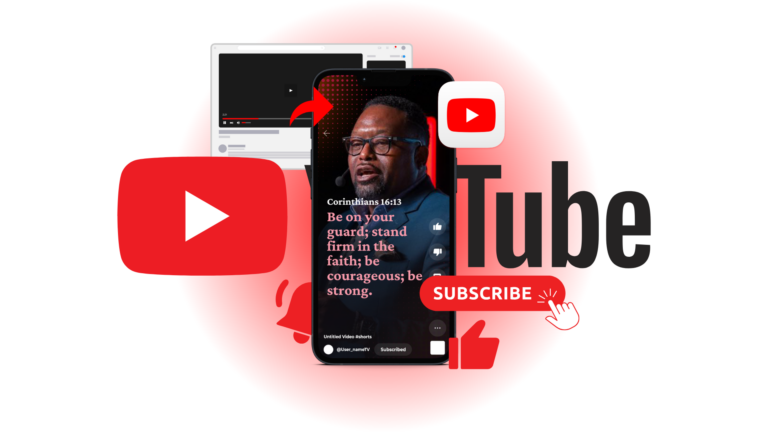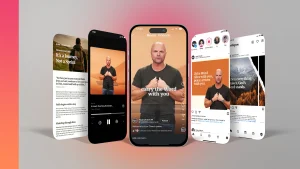Connecting with your church community goes far beyond Sunday services. A YouTube channel offers a powerful way to reach people where they are—online. Whether you’re sharing sermons, announcements, or inspiring messages, creating a church YouTube channel helps extend your ministry’s impact. It isn’t as complicated as it may seem, and with a few quick tips, you can start engaging your audience and growing your church’s presence today.
Understanding Your Audience
Before uploading a single video to your church’s YouTube channel, it’s important to know who your audience is. Understanding your viewers allows you to create content that connects with them personally and meets their needs. A “one-size-fits-all” approach doesn’t work here. Let’s break this down further.
Identifying Demographics
Who is your congregation? What’s your community like? These questions hold the key to creating videos that resonate. Start by analyzing the basic demographics of your church members and the surrounding local area. Consider factors like:
Age Groups: Are you speaking to mostly families, seniors, or young adults? Each group prefers different styles of content.
Cultural Backgrounds: Does your area have unique traditions or customs? This can influence topics and tone.
Language Preferences: For multilingual communities, subtitles or translation options can make a huge difference.
You can gather this information from attendance records, surveys, or even casual conversations. Dive into your community’s habits, too—are they more likely to watch videos on a phone or computer? Think about how people interact with content during their daily routines, and tailor your channel accordingly. In the end, understanding who will make your message more impactful.
Assessing Content Preferences
Once you know who you’re talking to, ask yourself: What do they actually want to see on your church YouTube channel? Don’t assume—find out. Here’s how:
Surveys: Share a quick form during Sunday service or in your church’s newsletter. Include simple questions like, “Would you watch a weekly devotional video?” or “What topics interest you most?”
Personal Feedback: Take the time to ask people in person. Casual chats can uncover topics or even creative video ideas you wouldn’t think of on your own.
Social Media: If your church uses platforms like Facebook or Instagram, scan the comments and polls for clues. Often, your audience will tell you what they value without you even asking directly.
It helps to brainstorm video ideas based on the feedback. Common suggestions might include:
Sermon recaps for those who miss Sunday service.
Q&A sessions with pastors or church leaders.
Content for kids, like Bible lessons through fun storytelling.
Understanding preferences isn’t only about gathering input—it’s about showing your audience that their needs and interests guide the channel. This builds trust and keeps people coming back for more.
Setting Up Your YouTube Channel
Getting your church started on YouTube begins with setting up your channel the right way. A strong foundation ensures that your videos reach your intended audience and create a lasting impression. Here’s how to get started step by step.
Creating a Google Account
Every YouTube channel is tied to a Google account, so you’ll need one to proceed. If your church doesn’t have a Google account yet, here’s how to create one:
Visit the Google Account Creation Page: Go to http://accounts.google.com.
Click “Create Account”: You’ll see an option to create an account specifically for “My business.” Select this to represent your church.
Enter Church Details: Use your church’s name instead of a personal name. This keeps it professional and easy to recognize.
Create a Strong Password: Use a mix of letters, numbers, and symbols to keep your account secure. Write it down or store it in a secure password manager.
Verify Your Account: Google may ask for a phone number or email verification. Follow the prompts, and you’re all set.
Once your Google account is ready, you can head to YouTube, log in, and follow the prompts to create your channel. Be sure to use the church’s name as the channel name to maintain consistency.
Channel Branding Essentials
Branding is how people will remember and connect with your channel. It reflects your church’s identity and makes your channel look polished and appealing.
Start with these key elements:
Channel Name: Use your full church name. If your church name is common, like “First Baptist Church,” consider adding your city or state, such as “First Baptist Church Dallas.” This helps people find your channel more easily.
Church Logo: Upload your church’s logo as your profile picture. Make sure it’s clear and properly sized (preferably 800 x 800 pixels). A logo helps people recognize your channel instantly.
Banner Image: Your banner is the first thing visitors see on your channel page. Include your church name, a tagline, and service times if relevant. Ensure the dimensions are optimized (2560 x 1440 pixels) and that vital info stays within the “safe zone” (1546 x 423 pixels).
Consistent Colors and Fonts: Match your visuals to your church’s branding. If your website or printed materials use specific colors and fonts, carry that over to your YouTube channel.
Think of these branding elements as the front door to your church online—make it welcoming and easy for people to recognize who you are.
Optimizing Channel Description and Tags
Your channel description and tags are more than just text—they’re tools to help people discover your videos. By optimizing them, you can make sure your church’s YouTube channel reaches the audience you’re trying to serve.
Here’s how to craft a great channel description:
Introduce Your Church: Start with a brief intro. For example, “Welcome to the official channel of Grace Community Church in Springfield. We’re here to share God’s word, inspire hope, and build community.”
Highlight Your Content: Mention what types of videos viewers can expect, like sermons, devotionals, or events. Keep it clear and specific.
Include Keywords: Add relevant terms like “church YouTube,” “online ministry,” and “sermon videos” naturally in your text. This improves your search engine visibility.
Add a Call-to-Action: Encourage visitors to subscribe. For example, “Subscribe to stay up to date with our weekly messages and more.”
When it comes to tags:
Use tags that relate to your church and the content you plan to post. For instance:
“church YouTube”
“weekly sermon videos”
“Christian inspiration”
“youth ministry resources”
Avoid overly generic tags like “video” or “fun,” as they don’t target your audience effectively.
These steps ensure your channel is ready to reach the right people while clearly reflecting your church’s mission.
Content Creation Strategies
Creating engaging content is the cornerstone of any successful church YouTube channel. The key is to provide value while reflecting your church’s unique mission and personality. Let’s explore a few crucial strategies to ensure your videos captivate your audience and keep them coming back.
Types of Videos to Create
Not sure where to start? Think about the types of messages and moments that matter most to your church community. Here’s a list of video ideas to kick things off:
Sermons: Share full sermons or create shorter recaps for those who may have missed Sunday service.
Testimonies: Highlight personal stories of faith from church members. Authentic and heartfelt, these videos inspire and connect on a deeper level.
Worship Services: Record live worship sessions so viewers can experience the power of music and praise from home.
Community Events: Document church fairs, outreach programs, or other events. This helps share the sense of fellowship with those who couldn’t attend.
Bible Studies or Devotionals: Provide valuable lessons based on scripture. These quick and focused videos engage viewers midweek.
Q&A with Pastors: Answer faith-based questions or even address trending topics from a Christian perspective.
These ideas cater to a wide range of viewer preferences while keeping your content versatile and meaningful. The goal is to bring the church experience online in a personal way.
Maintaining Consistent Upload Schedule
Consistency builds trust. When your church uploads videos on a regular schedule, it shows viewers you’re dependable. Plus, regular posting keeps your channel active, which YouTube’s algorithm favors.
Here’s how to create and stick to a schedule:
Start Small: Don’t overwhelm your team. Begin with a weekly schedule and adjust as you grow.
Pick a Day and Time: Choose a posting day and time most convenient for your audience. For instance, Sunday at 3 PM might work best for sermon recaps.
Use a Content Calendar: Track video ideas, and deadlines, and upload dates in a simple Google Sheet or planner to stay organized.
Keep Your Word: Think of your schedule as a commitment. If you promise viewers weekly videos, aim to deliver, even if it’s something short.
Think of uploading like hosting a weekly Bible study—your audience expects it. Consistency not only keeps your subscribers engaged but also makes your church more discoverable.
Utilizing Quality Equipment
You don’t need a Hollywood budget to make great videos, but using the right equipment makes a big difference in quality. Let’s look at what you’ll need.
Camera: Many smartphones now shoot high-quality video. However, if you want to invest, affordable options like the Canon EOS M50 or Sony ZV-1 are excellent picks for beginners.
Tripod: A steady shot looks professional. Inexpensive tripods for phones or cameras are available on Amazon.
Microphone: Clear audio is just as important—viewers will tolerate an average picture, but poor sound drives them away. Consider budget-friendly mics like the Boya BY-M1 Lavalier or Rode VideoMic for clear audio.
Lighting: Even basic lighting can improve video quality. Use cheap ring lights or sit near natural light sources like windows.
Editing Software: Free programs like iMovie (Mac) or DaVinci Resolve (PC) work well for basic video edits. You can also use Canva’s video creator for simple trimming and captioning.
Start where you are, but upgrade over time as needed. Think of better equipment as tools that help amplify your message, not distractions from it.
Promoting Your Channel
Building a church YouTube channel is just the start. To grow your audience and foster engagement, you’ll need effective promotion. Let’s explore two simple yet impactful ways to get the word out and drive traffic to your channel.
Leveraging Social Media
If your church is already on social media, you have a built-in audience ready to support your YouTube channel. Each post is an opportunity to guide people toward your content. Here’s how to make it work:
Share Direct Links: Post a link to your latest video directly on platforms like Facebook, Instagram, and Twitter. Add a short, engaging caption that explains why people should watch.
Create Teasers: Trim short clips from your videos (15-30 seconds) and share them as “sneak peeks” on Instagram Stories or TikTok. Include a call-to-action like, “Watch the full sermon on our YouTube channel!”
Optimize Post Timing: Post when your church community is most active. For example, afternoons or evenings might capture more attention than early mornings.
Use Hashtags: Add relevant tags like #ChurchYouTube, #FaithOnline, or #SundaySermon to reach people interested in similar content.
Pin It: On Facebook and Twitter, pin an announcement about your YouTube channel to the top of your profile. It’ll ensure visitors see it right away.
Social media acts as the bridge from your congregation to the wider online community. By consistently sharing, you’re inviting people to explore faith on their own time, wherever they are.
Engaging Congregation Support
Your church members are a valuable resource for promoting the channel. Think of them as your biggest advocates. So, how do you encourage them to help?
Ask for Shares: During Sunday service or events, simply ask members to share videos with their friends and family. A personal recommendation goes a long way.
Incorporate Videos in Ministry: Play snippets during gatherings, Bible studies, or outreach events. This not only introduces your channel to attendees but reinforces its value.
Create a Challenge: Host a “subscribe and share” challenge within your congregation. Set a goal (e.g., 100 subscribers in 30 days), get everyone involved, and celebrate the milestone.
Feature Members in Videos: Include familiar faces in your content—testimonies, service highlights, or behind-the-scenes moments. People love sharing videos when they’re part of the story.
Promote via Church Communication: Mention your YouTube channel in newsletters, bulletins, and announcements. Add the link everywhere—on your website, emails, even on physical flyers.
When your congregation is excited, they’ll naturally spread the word. It’s like planting seeds—the more people share, the more your ministry grows.
Promoting a church YouTube channel isn’t about gimmicks; it’s about creating meaningful connections. With a little effort and teamwork, your channel can extend its reach and touch hearts far beyond your Sunday service.
Measuring Success and Engagement
Once your church’s YouTube channel is up and running, tracking its performance is essential. Understanding how your channel is doing helps ensure your efforts are making an impact. Watching numbers alone isn’t enough—it’s about interpreting them and using that knowledge to connect with your audience in meaningful ways.
Understanding YouTube Analytics
Think of YouTube Analytics as your channel’s report card. It provides detailed insights into how your videos are performing and how viewers are engaging with your content. This tool is vital for making informed decisions and improving your strategy over time.
Here are the key metrics to pay attention to:
Views: How many times has the video been watched? This shows what topics or formats resonate most.
Watch Time: How long are people watching? Longer watch times suggest your content is engaging and relevant.
Audience Retention: Where do viewers drop off? If certain segments repeatedly cause people to leave, refine your content to hold attention.
Click-Through Rate (CTR): This is the percentage of viewers clicking on your video when they see it. A strong thumbnail and title improve this.
Subscriber Growth: Are new people subscribing, or are existing viewers leaving? This metric reflects the effectiveness of your content in building community.
Engagement: Comments, likes, and shares directly measure how involved viewers feel. These are the heartbeat of audience connection.
To access these insights, log in to YouTube Studio and explore the dashboard. Check the “Analytics” tab often to see what’s working (and what’s not). It’s like having a compass—it points you in the direction of improvement.
Adjusting Strategies Based on Feedback
Metrics provide numbers, but feedback brings them to life. Viewer comments, messages, and even silence offer clues about what your audience wants or needs. Ignoring feedback is like skipping a conversation—you miss out on ways to grow.
Here’s how to adapt:
Pay Attention to Trends: Are certain topics getting more views? Double down on those themes. If a specific video flops, evaluate why it didn’t connect.
Read Comments Closely: Comments are goldmines of feedback. If viewers repeatedly say they want more worship music or Q&A sessions, listen. Address their needs in your future videos.
Test and Learn: Get experimental. Try new formats, styles, or lengths for your videos. Use analytics to assess whether the changes improve your results or not.
Adapt Based on Retention: Let’s say your analytics reveal drop-off moments two minutes into a 10-minute video. Consider shortening your videos or getting to the point faster.
Ask for Input: Don’t be afraid to ask your audience in videos or posts. A simple “What would you like to see next?” can spark valuable ideas.
Adjusting strategies isn’t about chasing trends—it’s about serving your congregation better. Think of it like tuning an instrument. Small adjustments can make your channel more harmonious with your viewers’ desires, leading to deeper engagement.
Tracking success and making adjustments ensures your church’s YouTube channel continues to grow and fulfill its purpose. By focusing on metrics and feedback, you create content that not only reaches more people but also leaves a lasting impact.
Extend Your Churches Reach
Starting a church YouTube channel is an opportunity to share faith, foster community, and expand your reach. With a clear understanding of your audience, consistent content, and intentional promotion, your channel can become a valuable extension of your ministry.
The steps may seem overwhelming at first, but progress comes with practice. Begin where you are, and don’t wait for perfection. Each video is a chance to connect with someone searching for hope.
Take the first step today—set up your channel, create meaningful content, and start inviting others to join you. Your church’s voice matters, and YouTube can help amplify it.





